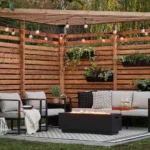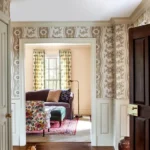Selecting furniture that complements your home’s interior design is crucial for creating a cohesive and visually appealing space.
The right furniture enhances not only the aesthetics but also the functionality of your rooms.
From understanding your style preferences to considering the perfect blend of materials, colors, and dimensions, each decision plays a vital role in achieving harmony.
This guide dives into practical strategies to choose furniture that seamlessly aligns with your design vision while balancing comfort and practicality.
Whether you prefer modern minimalism or traditional charm, these expert tips will help you make informed choices that elevate your living space to the next level.
Understanding Your Interior Design Style
Before diving into furniture selection, it’s crucial to identify your home’s interior design style. Knowing your style ensures that every piece of furniture you choose contributes to a cohesive look.
Common Interior Design Styles
| Style | Key Characteristics | Furniture Examples |
|---|---|---|
| Modern | Clean lines, minimalistic, neutral colors | Low-profile sofas, glass coffee tables, sleek dining sets |
| Traditional | Classic, ornate details, rich wood tones | Wingback chairs, mahogany dining tables, tufted sofas |
| Industrial | Raw, edgy, exposed materials like brick and metal | Metal bar stools, reclaimed wood tables, leather chairs |
| Scandinavian | Simple, functional, light tones | White bookshelves, wooden chairs, neutral-toned sofas |
| Bohemian | Eclectic, vibrant, layered textures | Patterned ottomans, wicker chairs, colorful rugs |
Tips for Identifying Your Style
- Examine Your Current Space: Look at existing decor elements like paint colors, flooring, and lighting.
- Seek Inspiration: Explore magazines, Pinterest, or design blogs for ideas that resonate with you.
- Prioritize Functionality: Consider how you’ll use each room and what furniture types are essential.
Assessing Your Space and Layout

The next step in furniture selection is evaluating your space. Each room has unique requirements, and the dimensions and layout of your home significantly influence your choices.
Measuring Your Space
- Room Dimensions: Measure the length, width, and height of the room.
- Doorways and Hallways: Ensure furniture pieces can fit through entryways.
- Clearance Space: Leave enough space for movement around furniture.
Creating a Layout Plan
A layout plan helps you visualize how furniture will fit and function within the room. Tools like online room planners or graph paper can simplify this process.
Table: Furniture Proportions for Different Room Sizes
| Room Size | Ideal Furniture Features |
|---|---|
| Small Rooms (<200 sq ft) | Compact, multi-functional, space-saving designs |
| Medium Rooms (200-400 sq ft) | Balanced furniture pieces that offer functionality and aesthetics |
| Large Rooms (>400 sq ft) | Statement furniture, sectional sofas, and larger tables |
ALSO READ: How to Decorate with Indoor Plants for a Fresh Look
Choosing the Right Materials
The material of your furniture affects its durability, maintenance, and overall appearance. It’s essential to select materials that align with your lifestyle and interior design style.
Popular Furniture Materials
| Material | Advantages | Disadvantages |
|---|---|---|
| Wood | Durable, timeless, versatile | Can be heavy, susceptible to scratches |
| Metal | Modern, sturdy, low-maintenance | Can feel cold or industrial |
| Glass | Sleek, reflective, enhances light | Prone to smudges, less durable |
| Upholstery | Comfortable, customizable colors/patterns | Requires cleaning, can wear over time |
| Leather | Luxurious, durable, easy to clean | Expensive, limited color options |
Coordinating Colors and Patterns

Color coordination is key to creating a harmonious space. The furniture you choose should complement the existing color scheme and patterns in your home.
Tips for Color Coordination
- Stick to a Palette: Choose a primary, secondary, and accent color for your room.
- Neutral Base: Opt for neutral tones for larger pieces like sofas, then add color through cushions and decor.
- Balance Bold Patterns: Pair bold patterns with solid colors to prevent visual overwhelm.
Table: Popular Color Schemes and Matching Furniture
| Color Scheme | Recommended Furniture Colors |
|---|---|
| Monochromatic (e.g., Blue) | Navy sofa, light blue rug, teal cushions |
| Neutral (e.g., Beige) | White chairs, beige sofa, brown accents |
| Contrasting (e.g., Black & White) | Black dining table, white chairs, silver decor |
ALSO READ: How to Upgrade Your Kitchen on a Budget?
Balancing Functionality and Aesthetics
While aesthetics is important, furniture must also serve practical purposes. Balancing beauty with functionality ensures your home is both stylish and comfortable.
Questions to Ask Yourself
- Who will use this space? (e.g., children, pets, guests)
- What activities occur here? (e.g., dining, working, relaxing)
- What is the room’s focal point? (e.g., a fireplace, a window)
Multi-Functional Furniture Ideas
- Sofa Beds: Perfect for guest rooms or small apartments.
- Storage Ottomans: Provide extra seating and hidden storage.
- Extendable Tables: Ideal for hosting gatherings in compact spaces.
Adding Accent Furniture and Decor

Accent furniture and decor are the finishing touches that bring personality to your space. These items complement primary furniture and often reflect your unique style.
Examples of Accent Furniture
- Side Tables: Perfect for holding lamps or books.
- Accent Chairs: Add a pop of color or texture to a room.
- Bookshelves: Showcase your collection while adding vertical interest.
Budgeting and Shopping Tips
A well-thought-out budget prevents overspending and helps prioritize essential items. Here’s how to approach shopping for furniture:
Setting a Budget
- List Essentials: Focus on large items first, like sofas and beds.
- Allocate Funds: Spend more on high-use items and save on decorative pieces.
- Leave Room for Flexibility: Allow a buffer for unexpected costs.
Shopping Smart
- Compare Prices: Check online and in-store for the best deals.
- Inspect Quality: Look for solid construction, durable materials, and warranties.
- Consider Secondhand: Vintage or thrifted pieces can add character and save money.
ALSO READ: How to Mix Modern and Traditional Styles in Interior Design?
Conclusion
Selecting furniture that complements your home’s interior design is an art that combines style, practicality, and personal taste.
By understanding your design style, assessing your space, and carefully choosing materials, colors, and patterns, you can create a cohesive and inviting home environment.
Remember, furniture is an investment. Prioritize quality and timeless designs that will serve you well for years to come.
With the right approach, you can transform any space into a reflection of your personality and lifestyle.







